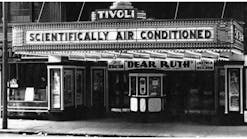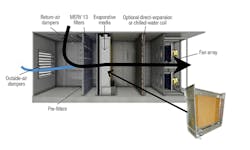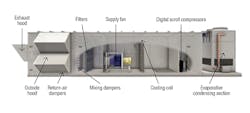Typical standard rooftop air-handling units (AHUs) simply are not designed to provide the temperature control and redundancy demanded by mission-critical data-center environments. For instance, over a 10-year period, a typical standard rooftop AHU may run for about 30,000 hours, compared with a data-center cooling system, which may run for 80,000 hours or more. Also, while typical service response time for traditional comfort cooling systems is 12 to 24 hours, the criticality of data-center operations demands a response time of no more than two to four hours.
AHUs designed for data centers, which until recently were available only for large enterprise and hyperscale operations, offer a level of protection, reliability, efficiency, and flexibility needed for these unique environments. They provide an opportunity to reliably and cost-effectively manage heat in a facility.
This article will discuss four of the most common types of air-handling systems for data centers:
- Indirect evaporative free-cooling system.
- Direct evaporative free-cooling system.
- Direct-expansion (DX) system.
- Chilled-water system.
The Added Benefit of Intelligent Controls
Before we discuss the four types of air-handling systems, it is important to mention the role intelligent controls play in maximizing efficiency, availability, and protection.
A typical misconception is that all controls require significant customization to cooling units and components or to building management systems. In reality, certain thermal-management controls integrated into many AHUs for data centers require little, if any, customization and provide exceptional protection and efficiency.
At the unit level, intelligent controls constantly monitor and auto-tune key operating parameters, such as fan speed, compressor utilization, and economization. If a deviation from a set point is detected, the control algorithms adjust operations accordingly. In the case of AHUs employing economization, intelligent controls can ensure—in real time—the optimum mix of scavenger-fan and water usage; offer power metering on supply fans, pumps, and exhaust fans for energy optimization; and control the economizer based on supply temperature and enthalpy.
At the system level, intelligent controls enable machine-to-machine communication to prevent units from fighting one another and to allow them to function as an aligned system, efficiently adapting to changes in facility-level demand. This level of teamwork is accomplished with advanced algorithms that automatically adjust airflow, temperature, and economizer operations based on information-technology (IT) loads and outdoor conditions. This coordination of multiple cooling units can help to achieve annual mechanical power-usage effectiveness (PUE) well under 1.2 and operate a group of units up to 50 percent more efficiently than even the best units operating on their own.
Indirect Evaporative Free-Cooling System
An indirect evaporative free-cooling system (Figure 1) typically is a large unit outside of a data center. It features two air streams: Hot data-center return air (primary stream) is taken through a heat exchanger, where it is cooled by outside scavenger air (secondary stream) that has been cooled or preconditioned by evaporating water sprayed onto the heat exchanger. A blower then circulates the cooled primary air throughout the data center, while the secondary air is exhausted outdoors without any mixing of the air or any outside air entering the data center.
Unit controls operate the scavenger fan according to the unit’s mode of operation, controlling supply air to a user-adjustable set point. During cold ambient conditions, when the unit is operated in dry mode, the controller adjusts cooling capacity by modulating the scavenger fan to the desired leaving-air set point. The scavenger fan is sped up to increase cooling capacity or slowed down to decrease cooling capacity.
When outdoor temperature rises and the unit is unable to achieve the desired set point efficiently using only the heat exchanger in dry mode, the unit pumps are activated, and water is sprayed over the heat exchanger. This increases the capacity of the heat exchanger by bringing down the outdoor air to near the wet-bulb condition.
While this method requires a constant supply of treated water, no moisture from the secondary air stream is transferred to the primary air stream. This means air introduced back into the data center is dry, humidity levels are low, and no outside air is required for economizing. Additionally, electrical infrastructure can be downsized to realize a low initial cost per kilowatt.
Green House Data, a cloud-hosting, colocation, and managed-IT provider, recently deployed four 300-kW indirect evaporative free-cooling air handlers in its facility in Cheyenne, Wyo. The system uses 90 to 95 percent less energy than conventional data-center air conditioners and has been instrumental in achieving the target PUE of 1.14.
Direct Evaporative Free-Cooling System
In a direct evaporative free-cooling system (Figure 2), hot return air and outside air are mixed by adjusting damper position on the unit controller. The hot, dry mixed air is pulled through a filter and a water-saturated medium. Heat in the air evaporates the water. The resulting moist, cool air then is released through a blower back into the data center.
Typically, a direct evaporative free cooler is a large unit deployed outside of a data center. Often, a full containment system with higher supply and return temperatures is recommended. A direct evaporative free-cooling system is well-suited for geographic locations where the outside air is cool, humidity is low, and data-center managers are willing to operate within wider temperature and humidity ranges. Because there is no compressor, significantly less energy than with other forms of cooling is required, with the water pump and fan accounting for most of the consumption. With this design, electrical infrastructure can be downsized, resulting in kilowatt-per-unit readings lower than those with other types of air handlers.
A direct evaporative free-cooling unit introduces outside air to a data center and requires a constant supply of treated water.
DX System
Typically, a DX system (Figure 3) is a roof-mounted unit serving a single- or two-story building. Often, it requires supply and/or return ductwork for air distribution. In basic terms, a DX system is characterized by the use of a thermal-management system utilizing refrigerant to cool air directly, as opposed to utilizing a chilled-water loop to facilitate heat removal between refrigerant and the ambient environment.
DX systems, which easily accommodate modular build-outs, rely on three primary energy-consuming components: compressors, condensers, and evaporator fans. Two heat exchanges—indoor air to the refrigerant and the refrigerant to outdoor air—take place to remove heat. As such, this type of design often is capable of achieving a high level of efficiency with the added benefit of a simplified infrastructure, typically with no single points of failure.
Because DX systems typically are roof-mounted, a building’s roof structure may need to be improved. Also, low ambient conditions can cause operation issues with DX units.
Chilled-Water System
A chilled-water system (Figure 4) can be a vertical unit along the perimeter or in the gallery of a building that discharges into a raised floor or, in the absence of a raised floor, a horizontal unit in the gallery or outside of a building. It uses a facility’s chilled-water systems as the cooling source for around-the-clock operation. The chiller cools water, which is circulated through coils inside of the chilled-water AHU. As warm air from the data center runs over the coils, heat is transferred to the water inside of the coils, and the now-cooler air is returned to the data center. The warmer water inside of the coils is returned to the chiller, where heat is transferred to a second stream of water flowing through a cooling tower and expelled to the outside.
This design operates with a high sensible heat ratio, ensuring proper humidity is maintained. It is ideal for precise maintenance of data-center conditions and is very efficient when paired with higher water-loop temperatures and water-side or air-side economizers.
Indoor units typically are easy to service and commission. However, there can be a significant upfront cost associated with the needed chiller plant, and as with direct and indirect evaporative free-cooling systems, a constant supply of treated water is needed.
Conclusion
Air-handling technology designed for data centers offers an opportunity to reliably and cost-effectively manage heat in a facility. It is important that data-center and facility managers understand the options available to them to ensure they implement the design that will achieve the desired efficiency and PUE.
As vice president, North America marketing, thermal management, for Emerson Network Power, John Peter “JP” Valiulis is responsible for evaluating new technologies and developing highly efficient and reliable controls and product solutions for mission-critical applications. Previously, he held positions in strategic planning, new-venture development, and product marketing with SPX Cooling Technologies, PepsiCo, and The Walt Disney Co. He has a bachelor’s degree in economics from Georgetown University and a master’s degree in business administration from The Wharton School, The University of Pennsylvania.
Did you find this article useful? Send comments and suggestions to Executive Editor Scott Arnold at [email protected].














